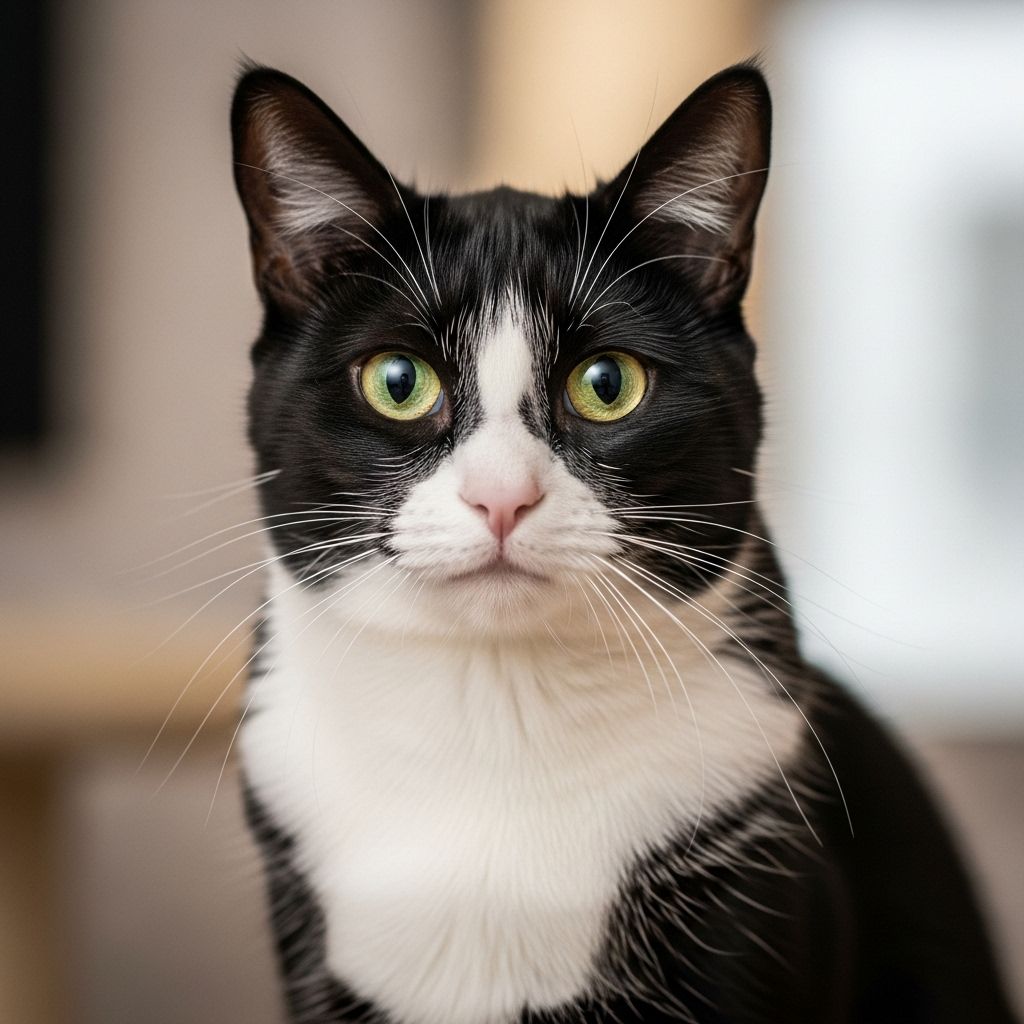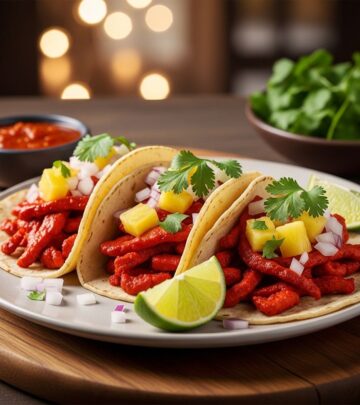Black And White Cat Breeds: 13 Stunning Bicolor Beauties
Discover the most elegant and charming bicolor feline companions that combine sophistication with playfulness

Image: HearthJunction Design Team
There’s something undeniably captivating about black and white cats. Whether they sport the classic tuxedo pattern that gives them a permanently dressed-up appearance or showcase playful splotches of contrasting colors, these bicolor beauties have charmed cat lovers worldwide. The striking contrast between dark and light creates visual interest that sets these felines apart from their solid-colored counterparts, making them particularly photogenic and distinctive.
Black and white cats have earned numerous endearing nicknames over the years—from “tuxedo cats” and “cow cats” to “piebald kitties” and “masked bandits.” Their distinctive appearance has made them popular in media and literature, with famous examples including Sylvester from Looney Tunes, Felix the Cat, and Dr. Seuss’s mischievous Cat in the Hat. Even the White House has welcomed these bicolor companions, with President Clinton’s beloved cat Socks being one of the most famous presidential pets.
What makes these two-toned treasures even more appealing is the wide variety of cat breeds that can display black and white coloration. From the elegant Persian to the energetic Cornish Rex and the rare Turkish Angora, there’s a black and white cat breed to match every personality and lifestyle preference. Whether you’re seeking a playful companion, a dignified lounger, or an affectionate cuddle buddy, you’ll find the perfect match among these distinguished felines.
Understanding Black and White Cat Patterns
Before diving into specific breeds, it’s helpful to understand the various patterns black and white cats can display. All black and white cats fall under the bicolor or piebald classification, but within this category, several distinct patterns exist:
- Tuxedo: The most recognizable pattern features a predominantly black coat with white on the chest, belly, paws, and sometimes the face, resembling a formal tuxedo suit.
- Harlequin: These cats display large patches of black and white, often in roughly equal proportions, creating a playful, somewhat random appearance.
- Van: A mostly white coat with black coloration primarily on the head and tail, with minimal marking on the body.
- Mask-and-Mantle: Black coloration covers the top of the head and back like a cape or mantle, with the rest of the body being white.
- Cap-and-Saddle: Similar to mask-and-mantle but with a smaller black area covering just the top of the head (cap) and part of the back (saddle).
These patterns result from specific genetic combinations, with the white spotting gene determining how much white appears in the coat. Now, let’s explore 13 cat breeds that commonly display these striking black and white patterns.
1. Cornish Rex
The Cornish Rex stands out not just for its potential black and white coloration but for its distinctive appearance. With large ears, slender builds, and remarkably short, curly coats, these cats are instantly recognizable. Their fur consists of tight, curly rows that feel like velvet to the touch, earning them comparisons to the greyhound of the cat world.
Beyond their unique appearance, Cornish Rex cats are known for their energetic, sociable personalities. These intelligent felines thrive on human company and can learn an impressive array of tricks. Some even serve as therapy animals due to their gentle, affectionate nature. A black and white Cornish Rex is particularly striking, with the contrasting colors highlighting their unusual coat texture.
2. Persian
Persian cats represent luxury in the feline world with their long, flowing coats and distinctive flat faces. When sporting a black and white pattern, these cats become even more dramatic in appearance. Through selective breeding, Persians are available in numerous colors and patterns, including beautiful bicolor combinations.
Known for their sweet, gentle temperaments, Persian cats prefer calm environments where they can lounge regally on soft surfaces. Their long coats require significant maintenance, including daily brushing to prevent mats and tangles. In 2015, the Persian cat ranked as the second most popular breed in America, speaking to their enduring appeal despite the grooming commitment they require.
It’s worth noting that while their flat faces contribute to their distinctive look, this feature can sometimes lead to health concerns. Responsible breeders work to maintain a balance between the breed’s characteristic appearance and overall health.
3. Scottish Fold
The Scottish Fold’s most distinctive feature is immediately apparent: their forward-folded ears give them an owl-like expression that many find irresistibly cute. This characteristic results from a natural genetic mutation affecting cartilage. When combined with a black and white coat pattern, Scottish Folds look particularly charming and unique.
These cats have earned a reputation for being exceptionally loving companions. They form strong bonds with their human families and often follow their favorite people from room to room. Scottish Folds can have either short or long hair, and their coats come in various patterns, including striking black and white combinations.
Due to their unusual appearance and sweet temperaments, Scottish Folds are among the most sought-after cat breeds. They tend to be playful but not hyperactive, making them suitable for various living situations, from spacious homes to apartments.
4. Siberian Cat
The Siberian cat brings together stunning looks and remarkable adaptability. This ancient breed from Russia features a medium to long coat that evolved to withstand harsh northern winters. When sporting black and white coloration, Siberians showcase dramatic contrast between their dark and light patches.
Also known as the Siberian Forest Cat or Moscow Semi-Longhair, this breed combines impressive size with extraordinary agility. Despite their substantial build, Siberians can leap great heights with surprising grace. Another appealing quality is their partially hypoallergenic coat, which produces fewer allergenic proteins than most cat breeds, making them a potential option for some allergy sufferers.
Siberian cats are intelligent, loyal, and playful companions who generally get along well with children and other pets. Their thick coats require regular grooming, especially during seasonal shedding periods, but many owners find the maintenance worthwhile for such affectionate and athletic companions.
5. Turkish Angora
The elegant Turkish Angora boasts an ancient lineage dating back to 17th-century Turkey. These refined cats are most commonly seen in pure white, but they also appear in various other colors and patterns, including striking black and white combinations. Many cat historians consider the Turkish Angora the original source of both the white coat color and long hair in domestic cats.
With their silky, medium-length coats and graceful bodies, Turkish Angoras embody feline elegance. They typically have large, almond-shaped eyes that can be blue, green, amber, or even odd-colored (one of each). Their personalities tend to be playful, intelligent, and sometimes mischievous, with many Angoras enjoying interactive games and even learning to fetch.
Despite their delicate appearance, Turkish Angoras are surprisingly athletic and agile. They form strong bonds with their human families and often appoint themselves as household supervisors, keeping track of everyone’s activities with keen interest.
6. Maine Coon
As America’s native gentle giant, the Maine Coon combines impressive size with a sweet disposition. These cats can weigh up to 18 pounds or more, with males typically larger than females. When displaying a black and white coat pattern, Maine Coons look particularly majestic, with their contrasting colors accentuating their substantial frames.
Distinguishable by their tufted ears, bushy tails, and rectangular bodies, Maine Coons have adapted to harsh climates with their water-resistant, shaggy coats. Despite their wild appearance, they’re known for their docile, friendly temperaments, often described as “gentle giants.” Many Maine Coons enjoy water play more than typical cats and communicate with distinctive chirps and trills rather than standard meows.
These intelligent cats maintain a playful attitude well into adulthood, making them entertaining companions for families. Their thick coats require regular grooming to prevent matting, especially around the neck and hindquarters where the fur is longest.
7. American Shorthair
The American Shorthair represents one of the most popular and adaptable cat breeds in the United States. Descended from cats that came over on the Mayflower and other early ships, these felines were valued as efficient rodent controllers. Today, they’re cherished as balanced family companions who adapt well to various living situations.
When sporting black and white patterns, American Shorthairs display clean, crisp contrasts between colors. Their medium-sized, muscular bodies and round faces give them a classic “cat next door” appearance that appeals to many admirers. With an average lifespan of 15-20 years, these cats offer long-term companionship with relatively few health concerns.
American Shorthairs balance playfulness with independence. They enjoy interactive play but are also content to entertain themselves when their humans are busy. Their short, dense coats require minimal grooming—weekly brushing is usually sufficient to keep shedding under control.
8. Oriental Shorthair
The Oriental Shorthair brings dramatic elegance to the world of black and white cats. With their sleek bodies, angular faces, and large ears, these cats appear both exotic and sophisticated. They share many physical traits with their Siamese relatives but come in over 300 color and pattern combinations, including striking bicolor arrangements.
Personality-wise, Oriental Shorthairs are known for being vocal, intelligent, and deeply attached to their human companions. They thrive on interaction and can become lonely if left alone for extended periods. Many owners describe them as “Velcro cats” for their tendency to stick close to their favorite people.
Their short coats require minimal grooming, making them relatively low-maintenance in that regard. However, their need for mental stimulation and companionship means they benefit from puzzle toys, climbing structures, and ideally, feline or human companions who can keep them engaged.
9. Japanese Bobtail
The Japanese Bobtail brings unique charm with its distinctive bobbed tail, which results from a natural genetic mutation. Each cat’s tail is different—some resemble pom-poms, while others form curves or kinks—making every Japanese Bobtail one-of-a-kind. When appearing in black and white (often with red as a third color), these cats recall the famous “beckoning cat” or “Maneki Neko” figurines popular in Japanese culture.
Active and intelligent, Japanese Bobtails maintain kitten-like playfulness throughout their lives. They’re known for being talkative but not overly loud, communicating with a range of melodious chirps and trills. Many enjoy water play and can be taught to fetch, walk on leashes, or perform tricks.
Despite their exotic appearance, Japanese Bobtails are generally healthy and adaptable. They form strong bonds with their families but typically manage well with the hustle and bustle of active households, including those with children and other pets.
10. British Shorthair
The British Shorthair combines a sturdy build with a plush, dense coat that feels like a luxury teddy bear. While most famous in solid blue (gray), these cats also appear in beautiful black and white patterns that highlight their round faces and stocky bodies. Their distinctive round eyes and cheeks give them a perpetually smiling expression that many find irresistible.
Known for their reserved yet affectionate temperaments, British Shorthairs aren’t typically lap cats but show their devotion by staying close to their favorite people. They tend to be quiet, undemanding companions who adapt well to apartment living. Their independent nature means they can entertain themselves during the day, making them suitable for working households.
British Shorthairs mature slowly, not reaching their full physical and emotional development until around three years of age. Their dense coats require weekly brushing to remove loose hair, with more frequent grooming during seasonal shedding periods.
Frequently Asked Questions (FAQs)
Q: Are black and white cats considered lucky?
A: In many cultures, black and white cats, particularly tuxedo cats, are considered symbols of good fortune. In Britain and Ireland, a black and white cat visiting your home is thought to bring prosperity, while in Japan, black and white bobtails are often kept in businesses to attract customers.
Q: Do black and white cats have specific personality traits?
A: While coat color doesn’t determine personality, some studies suggest tuxedo cats may be more vocal and sociable than average. However, breed, individual temperament, and upbringing influence personality much more significantly than coat pattern.
Q: Are black and white cats more common than other coat patterns?
A: Black and white bicolor patterns are among the most common naturally occurring coat patterns in domestic cats. The genetic combination that produces these patterns is widespread in the general cat population.
Q: Do black and white cats require special grooming?
A: The grooming requirements depend on the breed and coat length rather than the color pattern. Long-haired black and white cats like Persians need daily brushing, while short-haired varieties like American Shorthairs require only weekly grooming sessions.
Q: Can all cat breeds come in black and white patterns?
A: While many breeds can display black and white coloration, some breed standards limit accepted colors. For example, Siamese cats are not recognized in black and white patterns by most cat associations, though their Oriental Shorthair cousins can display these colors.
References
- https://www.thesprucepets.com/black-and-white-cat-breeds-4843190
- https://cats.com/different-types-of-black-and-white-cat-coat-patterns
- https://www.catsluvus.com/cat-grooming/black-and-white-cat-breeds-a-guide-to-felines-with-classic-coat-patterns/
- https://www.countryliving.com/life/kids-pets/g62920622/black-and-white-cat-breeds-list/
- https://www.catster.com/cat-breeds/black-and-white-cat-breeds/
Read full bio of Shinta











